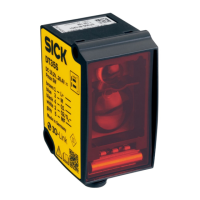
Do you have a question about the SICK DT35S and is the answer not in the manual?
| Number of Layers | 1 |
|---|---|
| Angular Resolution | 0.5° |
| Laser Class | Class 1 (IEC 60825-1) |
| Adjustment | Configurable via software |
| Output Type | PNP |
| Operating Voltage | 24 V DC |
| Switching Frequency | ≤ 1 Hz |
| Ambient Operating Temperature | -10°C to +50°C |
| Connection Type | M12 connector |
Overview of the DT35S safety-related distance sensors.
Details on operating instructions, target groups, symbols, and further resources.
Defines intended use, misuse, personnel requirements, hazards, and cybersecurity.
Covers hazards, liability limitations, modifications, signs, and standards.
Outlines operational safety measures and specific hazards.
Explains device warning labels and relevant safety standards.
Details on product types, software, scope, label, and layout.
Visual representation of the device and available accessories.
Explains core safety functions like distance and object detection.
Details on window functions, object detection, and related parameters.
Guidelines for transport, unpacking, inspection, and storage conditions.
Guidance on mounting sites and avoiding mutual interference.
Step-by-step instructions for physically mounting the sensor.
Instructions for wiring, connecting the device, and pin assignments.
Steps for installing SOPAS ET, driver, and establishing device connection.
Procedures for configuring the device and changing parameters.
Setting up device identification, main settings, and visualization.
Configuration of digital and analog outputs for various functions.
Explains device error states and internally detected errors.
Discusses undetected faults, manipulation, and environmental influences.
Considerations for machine integration, operating entities, and risk assessment.
Details on measurement deviations, response times, and safety ranges.
Analysis of dynamic deviations and allowed approach speeds.
Using the device in safety systems and improving diagnostic coverage.
Guidelines for performing regular checks to ensure protective function.
Precautions for safe handling, cleaning, and maintenance of the device.
Procedures for device repair and environmentally friendly disposal.
Physical dimensions and mechanical/electrical specifications of the device.
Performance levels, diagnostic coverage, and detection ranges.
Device performance characteristics and available interfaces.
Environmental conditions affecting device operation and immunity.
Information on conformity, certificates, and software licenses.